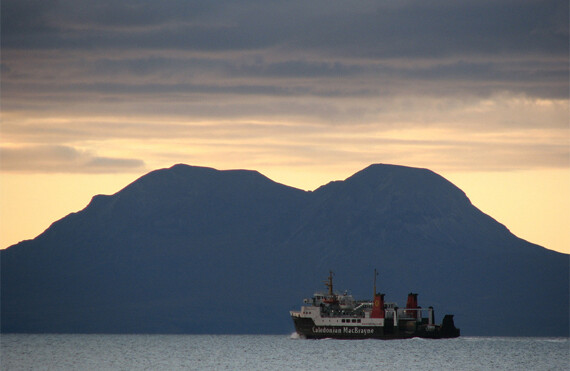The Scottish island of Islay (pronounced Eye-la) has long been known for distinctive single malt whisky tinged with sea air, peat, and even a slightly medicinal flavor from kelp that washes ashore. Its white distillery buildings cling to the rocky coastline like tenacious barnacles, witness to the ebb and flow for some two hundred years. Now the tide brings in the twenty-first century as the island plans to experiment with underwater turbines to harness the ocean's regular and relentless energy. Resembling submerged windmills anchored to the seabed, the turbines will employ adjustable-pitch blades to catch the current. Policy Innovations interviewed Tidal Energy Project Officer Andrew Macdonald of the Islay Energy Trust about community involvement in the project.
EVAN O'NEIL: Islay's tidal power demonstration project will be one of the first in the world. What stage is at currently?
ANDREW MACDONALD: The tidal project in the Sound of Islay is currently carrying out an Environmental Impact Assessment (EIA) prior to a consent application to the Scottish Government. If consent is given in 2010 then we would look to manufacture in 2011 and install in 2012.
This is a cutting-edge project, involving the deployment of ten 1 MW tidal turbines in 50 meters of water. The developer is ScottishPower Renewables and the candidate device is from Hammerfest Strom, who have had a prototype in the water for four years. As such, this is one of the best-tested devices available.
The EIA is a very rigorous process covering assessment of cetaceans, seabirds, shipping, commercial fishing, benthic ecology, archaeology, and noise. Tidal power is a new industry and it is essential that a thorough approach allows a clear baseline to be captured so that future impacts can be clearly understood.
EO: How did the Islay Energy Trust get started and what are its main goals?
AM: Islay has a long history of renewable projects, from the LIMPET wave generator at Portnahaven through to the wind turbine at Port Mòr and the photovoltaic tiles at Ionad Chaluim Chille Ìle [a Scottish Gaelic education center]. And maybe because it is an island and a small community Islay is very aware of energy supply and usage. Also as a rural area, there is a much closer attachment to the land than in more urban contexts.
IET was incorporated in 2004 after strategic reviews of the potential for renewable energy projects carried out by the Islay Development Company and the Islay Energy Steering Group, which were the forerunners to IET.
EO: Are all residents of Islay part of the Trust? What are the responsibilities and benefits of participating?
AM: IET is a community-owned charity and anyone over the age of 17 who lives or has property on Islay can become a voting member of the IET. There are currently around 150 members. It is managed by a board of trustees, which is elected by IET members. The aims are to develop and operate renewable energy projects and distribute funds generated for the benefit of the Islay community (as well as the Jura and Colonsay communities if the project involves sales of electricity to the grid; all three islands share the same electricity grid).
There are two drivers at the core of what we do. Firstly, generating renewable energy to help reduce climate change and encourage sustainable living. Secondly, developing these projects in a way that maximises the benefits to the local community—i.e., economic development through employment and direct dividends from the profits of projects.
Complementing the larger renewable projects, we are also running a Carbon Savings Project to encourage and help people to improve their own energy efficiency through insulation and micro-generation.
EO: How does the Trust fund its renewable energy projects? Are there investment partners?
AM: The Trust is a registered charity and as such we are dependent on funding from public and private bodies to operate. The Carbon Savings Project is funded by the Climate Challenge Fund. This is a fund set up by the Scottish Government which runs to the end of 2011. The tidal energy project is being developed by ScottishPower Renewables (SPR). As part of the Memorandum of Understanding between SPR and IET, local services such as the project officer position are funded by SPR.
EO: Have any Scottish or UK policies helped facilitate these investments?
AM: Tidal Power is at the early stages of development and public funding is important to kick-start what should be a great business opportunity for Scotland. The economics of the tidal project will depend on Renewable Obligation Certificates (ROCs) for the electricity that it generates.
EO: How are the dividends distributed? Do all residents receive an equal share?
AM: At present, IET projects haven't reached a position where they are generating income, so there are currently no dividends. Hopefully this will change, and the plan is that revenue would be received into a separate trust fund which would then distribute (or reinvest) the revenue. It is likely that this would be to community projects rather than to individuals. The specific criteria for this have not been defined.
EO: Underwater turbines won't be visible like wind installations, but has there been any NIMBYism or pushback against the projects?
AM: Generally, there is a lot of support for the project; it will bring economic benefits and it is great to see Islay involved in a world-leading development. There are potential impacts to commercial fishing; while vessels will be able to sail directly over the tidal array, it would be dangerous to place creels close to the turbines. While this will only affect a relatively small area of the Sound, it would be understandable if local fishermen oppose any proposed reduction in fishing grounds.
EO: Islay is also famous for its whisky distilleries. Any guess on when we'll see a 100 percent renewable scotch coming from your shores?
AM: Islay has some of the world's best whiskies and some of the most imaginative marketing. I wouldn't like to speak on their behalf but I think that Kilchoman and Bruichladdich source at least some of their barley locally and Bruichladdich is reported to be investigating use of waste products for electricity generation. Meanwhile excess heat from Bowmore is used to heat the swimming pool at the Mactaggart Leisure Centre in Bowmore.




